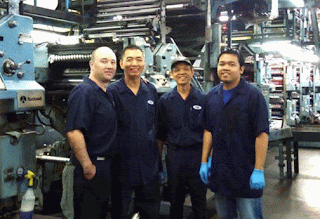 |
| Managers Must Control Wasted Time and Materials |
This effort starts with faster presses, which is normal, and thus continues into the crewing of those faster machines. In one recent press room change-over to higher speed presses crewing went from crews of over ten to a crew of six. Currently there is a drive to reduce the crew to five.
This concentration of effort to reduce crewing is typical in the industry today. It has the appearance of searching for the Holy Grail. The real kicker in this story is that this managerial focus is a throwback to the concepts of the early ‘40s when materials were cheap and the offset printing process was very heavily labor intensive. In today’s press rooms a reversal has taken place. Material costs have sky rocketed and high speed presses have reduced the labor intensity.
A typical job analysis will show that labor cost is only ten percent of the cost while materials make up 70 percent. Fixed costs are 20 percent. A manager must realize that he is on very dangerous ground if he crews his new high speed press at the minimum and compounds errors of omission. These errors can have a very serious impact on the 70 percent material costs.
The most critical factor to remember is that crew skill and their ability to perform does have a very serious impact on the overall cost of a job. For example the length of run is related to crew skill. One more important factor is the high rate of job turnover. The higher speeds shorten the length of each run which means that a larger part of the total productive day is spent on make readies. During make readies the size of the crew has a direct impact on the length of the make ready.
Waste is another major cost factor that is impacted directly by the ability of the crews to react quickly to problems, and more importantly to the prevention of problems. The length of the make ready and the waste incurred in each make ready are directly related to the strength of the crew. The more skilled hands available, the lower the waste on make ready. One extra man at $20.00 an hour could conceivably save thousands of dollars in waste alone.
 |
| Waste control is closely connected with morale. |
A recent activity survey showed that the typical offset press is not running 40% of the time. This breaks down into 23% on make ready and 17% on delays. During this down time the size of the crew has a critical impact on how long the delay or the make ready lasts. If a press is manned tightly to the minimum needed to run the press, you may find that the saving of a man at $10 an hour will have a very significant impact on the delay factor on the machine that is priced at $1000 an hour. That is a sample of voodoo economics and no motivational mumbo jumbo will correct the problem.
There is another factor to consider. That is morale. Crews are not prone to give their best effort if they feel the manning is inadequate. Sometimes the reaction is to slow down as a form of resistance to the management’s decision to low ball the manning. A good manager is not insensitive to basic requirements.
To improve your bottom line you must look at the press in terms of the total activity profile and direct your managerial skills toward the control of the major cost factors which are material cost and the machine time. People are not the prime targets anymore.
Man those presses, cut waste and delays, and then start counting your money. That is the new wave of good management!
by Frank Drazan
Comments
Post a Comment